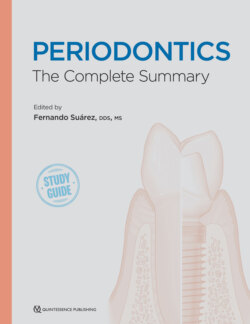Читать книгу Periodontics - Fernando Suarez - Страница 9
На сайте Литреса книга снята с продажи.
1 ANATOMY Miguel Romero Bustillos, DDS, PhD DEFINITIONS AND TERMINOLOGY
ОглавлениеAlveolar bone proper: Compact bone that composes the alveolus (tooth socket). Also known as the lamina dura or cribriform plate, the fibers of the periodontal ligament insert into it.
Alveolar process: The compact and cancellous bony structure that surrounds and supports the teeth.
Attached gingiva: The portion of the gingiva that is firm, dense, stippled, and tightly bound to the underlying periosteum, tooth, and bone.
Attachment apparatus: The cementum, periodontal ligament, and alveolar bone.
Biologic width: The dimension of soft tissue composed of a connective tissue and epithelial attachment extending from the crest of bone to the most apical extent of the pocket or sulcus. This term was recently redefined as “supracrestal tissue attachment.”2
Bundle bone: A type of alveolar bone, so-called because of the “bundle” pattern caused by the continuation of the principal (Sharpey) fibers into it.
Fibroblast: The predominant connective tissue cell; a flattened, irregularly branched cell with a large oval nucleus that is responsible in part for the production and remodeling of the extracellular matrix.
Free gingiva: The part of the gingiva that surrounds the tooth and is not directly attached to the tooth surface.
Gingival groove: A shallow, V-shaped groove that is closely associated with the apical extent of free gingiva and runs parallel to the margin of the gingiva. The frequency of its occurrence varies widely.
Gingival papilla: The portion of the gingiva that occupies the interproximal spaces. The interdental extension of the gingiva.
Hertwig epithelial root sheath (HERS): An extension of the enamel organ (cervical loop) Determines the shape of the roots and initiates dentin formation during tooth development. Its remnants persist as epithelial rests of Malassez in the periodontal ligament.
Lamina propria: In the mucous membrane, the connective tissue coat just beneath the epithelium and basement membrane. In skin, this layer is known as the dermis.
Mucogingival junction: The junction of the gingiva and the alveolar mucosa.
Osseointegration: A direct contact, at the light microscopic level, between living bone tissue and an implant.
Periodontal ligament (PDL): A specialized fibrous connective tissue that surrounds and attaches roots of teeth to the alveolar bone. Also known as the periodontal membrane.
Periodontium: The tissues that invest and support the teeth, including the gingiva, alveolar mucosa, cementum, periodontal ligament, and alveolar supporting bone. Also known as the supporting structure of the tooth.
Rete pegs: Ridge-like projections of epithelium into the underlying stroma of connective tissue that normally occur in the mucous membrane and dermal tissue subject to functional stimulation.
The periodontium comprises the supporting structures of the dentition. It is composed of four main elements: gingiva, cementum, periodontal ligament (PDL), and bone. Understanding this dynamic network of tissues is pivotal for the proper performance of the many procedures related to periodontal therapy. This chapter describes the different structures of the periodontium from microscopic and macroscopic points of view.
The attachment apparatus, also known as periodontal attachment, is an aggregate of tissues with the main function of anchoring teeth to the alveolus. It consists of cementum, alveolar bone, PDL, and gingiva. Several terms are highly relevant with this regard and are described by the American Academy of Periodontology (AAP) Glossary of Periodontal Terms (see sidebar).1
